Table of Contents
- Introduction
- Editor’s Choice
- Test and Measurement Equipment Market Overview
- Industry Revenue of Manufacture of Instruments for Measuring, Testing, And Navigation
- Operating Revenue of Measurement Equipment Manufacture
- Different Test and Measurement Equipment and Their Specifications
- Test and Measurement Export Statistics
- Test and Measurement Equipment Import Statistics
- Regulations for Test and Measurement Equipment
Introduction
According to Test and Measurement Equipment Statistics, Test and measurement equipment are essential tools used across industries to assess and analyze various characteristics of materials, components, and systems.
They encompass a range of instruments such as multimeters, oscilloscopes, vernier calipers, and spectrophotometers, facilitating tasks from measuring electrical signals to evaluating material strength.
These tools play crucial roles in ensuring product quality, supporting research and development efforts, and diagnosing faults in systems.
With accuracy, calibration, and safety as key considerations, the future of test and measurement equipment trends towards integration with IoT platforms, miniaturization for increased portability, and automation for improved efficiency.
Editor’s Choice
- The Global Test and Measurement Equipment Market revenue is expected to reach USD 54.2 billion by 2033.
- In the market for test and measurement equipment, organization size plays a pivotal role in determining market share distribution. Large enterprises dominate the market, accounting for 65% of the total share.
- The industry revenue for the manufacture of instruments and appliances for measuring, testing, and navigation in Germany has experienced notable fluctuations from 2012 to 2025.
- The operating revenue of the measurement equipment manufacturing sector in China has shown a consistent upward trend from 2008 to 2020, despite minor fluctuations in some years.
- In 2022, Germany emerged as the leading exporter of measuring or checking equipment, with an export value of USD 4.43 billion, accounting for 17.6% of the global market.
- In 2022, China led the global market for importing measuring or checking equipment, with imports valued at USD 324 billion, accounting for 21.1% of the total market.
- In the United States, regulations such as those outlined by the National Institute of Standards and Technology (NIST) and compliance with standards like ISO/IEC 17025 ensure high precision and calibration in measurement tools.

Test and Measurement Equipment Market Overview
Global Test and Measurement Equipment Market Size
- The Global Test and Measurement Equipment Market is poised for significant growth over the coming decade at a CAGR of 4.8%.
- In 2023, the market revenue is expected to reach USD 33.9 billion.
- This growth culminates in a projected market revenue of USD 54.2 billion by 2033.
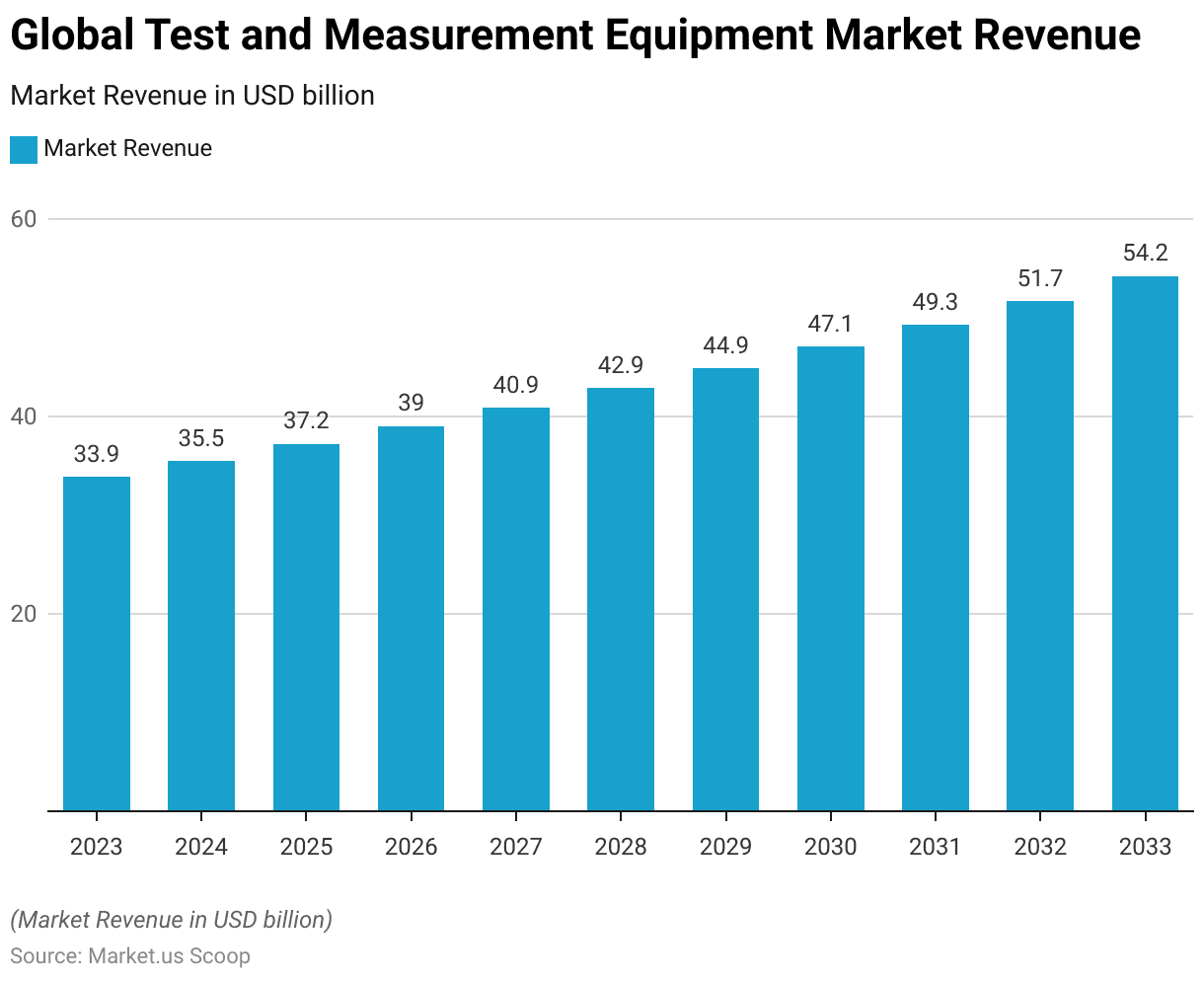
Global Test and Measurement Equipment Market Share – By Organization Size
- In the market for test and measurement equipment, organization size plays a pivotal role in determining market share distribution.
- Large enterprises dominate the market, accounting for 65% of the total share.
- In contrast, small and medium enterprises (SMEs) hold a 35% market share.
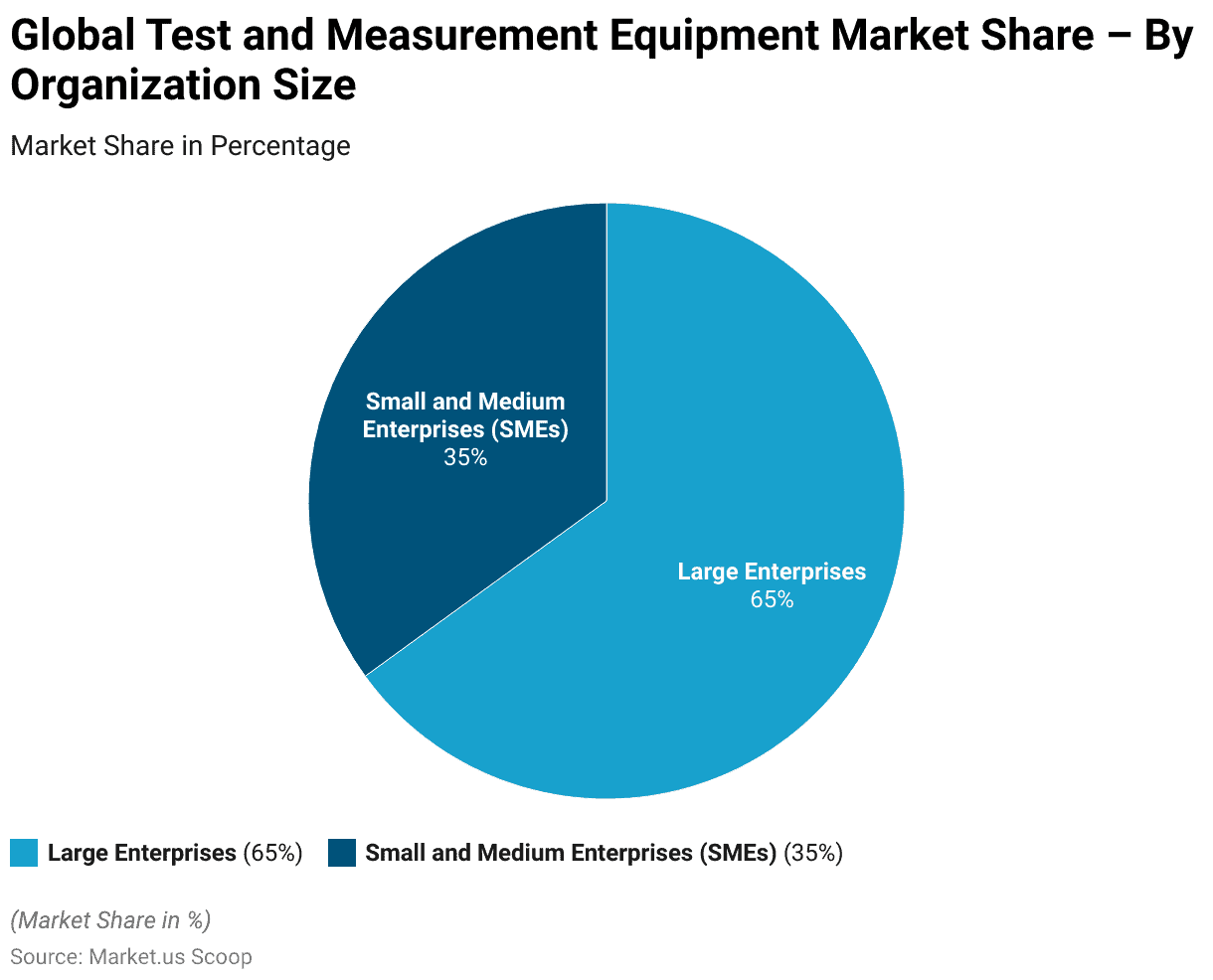
Manufacture of Instruments and Appliances for Measuring, Testing, And Navigation
- The industry revenue for the manufacture of instruments and appliances for measuring, testing, and navigation in Germany has experienced notable fluctuations from 2012 to 2025.
- In 2012, the revenue stood at USD 36.7 billion, increasing to USD 37.72 billion in 2013 and further to USD 40.3 billion in 2014.
- By 2022, the revenue climbed to USD 41.91 billion, and it is projected to continue growing, reaching USD 45.17 billion in 2023, USD 45.94 billion in 2024, and USD 46.46 billion in 2025.
Manufacture of Watches and Clocks
- In contrast, the manufacture of watches and clocks has maintained relatively stable but lower revenue figures.
- Starting at USD 0.58 billion in 2012, the industry saw an increase to USD 0.74 billion in 2013 and 2014.
- The market stabilized somewhat in the following years, with revenues of USD 0.5 billion in 2021 and USD 0.55 billion in 2022, and projected steady growth to USD 0.64 billion in 2023 and USD 0.65 billion in both 2024 and 2025.
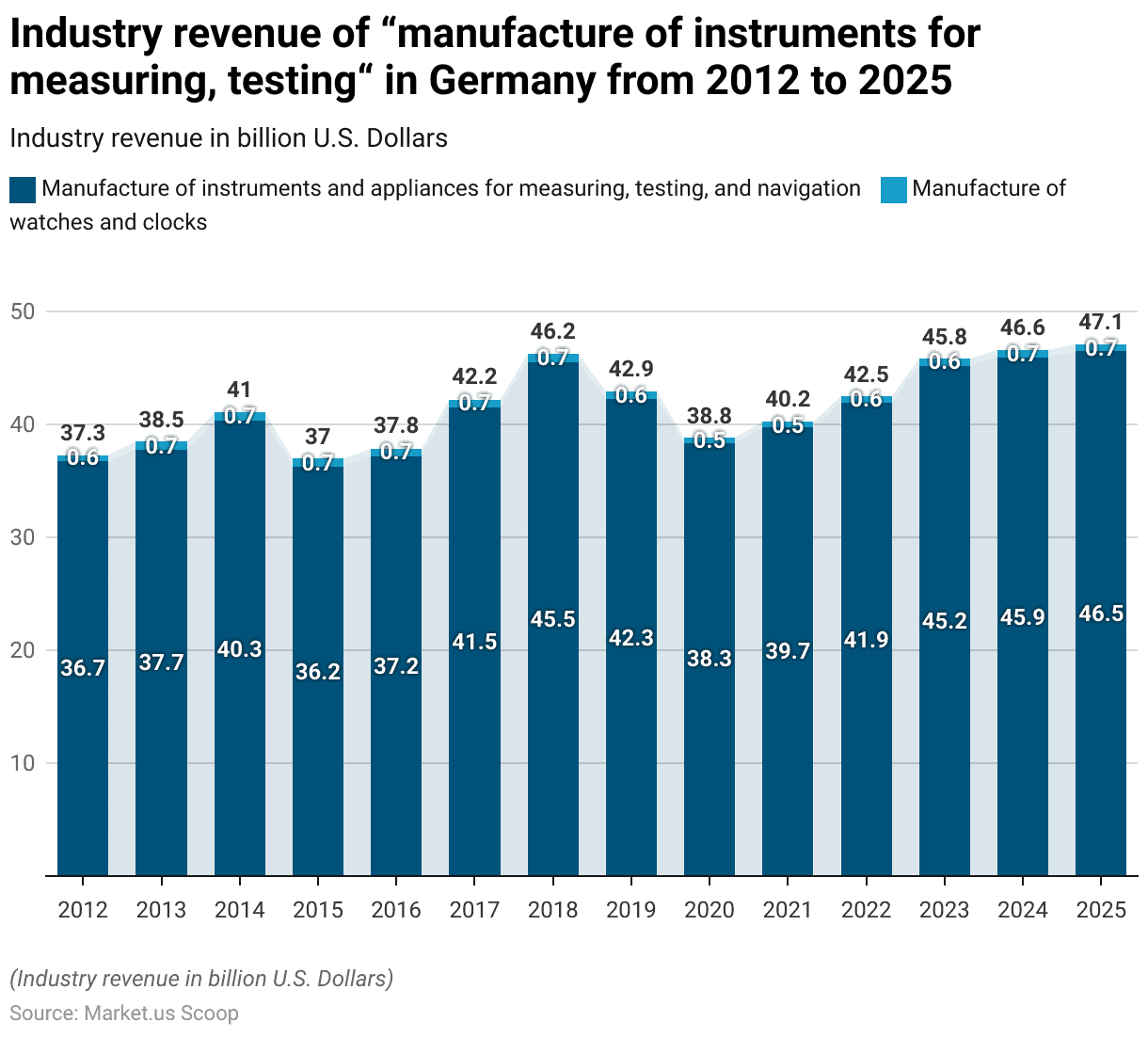
Operating Revenue of Measurement Equipment Manufacture
- The operating revenue of the measurement equipment manufacturing sector in China has shown a consistent upward trend from 2008 to 2020, despite minor fluctuations in some years.
- In 2008, the industry generated USD 1,551 million in revenue, which increased to USD 1,909 million in 2009.
- However, there was a slight dip in 2017 when the revenue slightly decreased to USD 3,192 million, remaining almost stable in 2018 at USD 3,190 million.
- In 2019, the revenue picked up again, reaching USD 3,330 million, but saw a minor decline to USD 3,307 million in 2020.
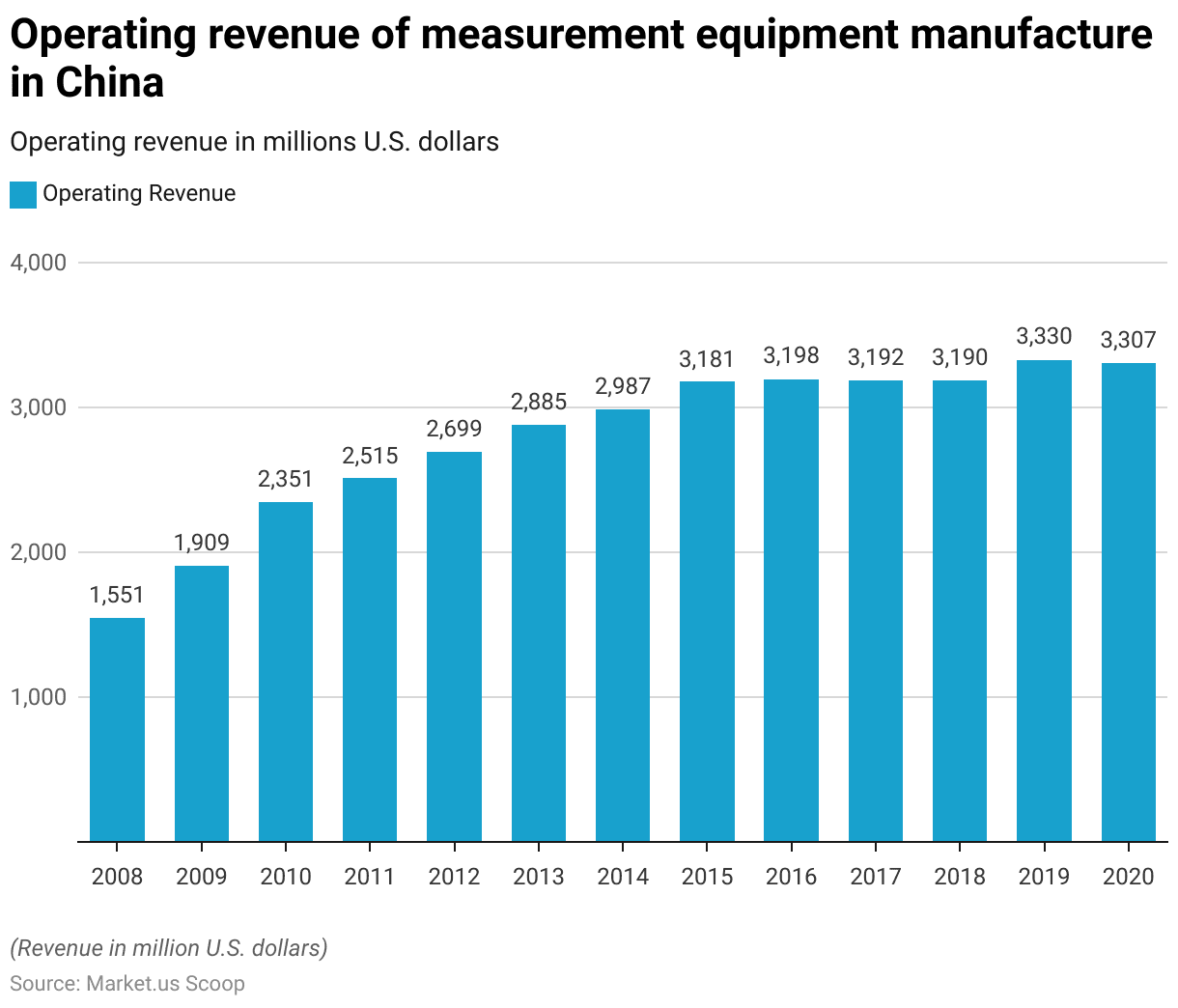
Different Test and Measurement Equipment and Their Specifications
Multimeter
- Ensuring a digital multimeter’s accuracy is vital and varies by application. For basic tasks like checking live receptacles, a ±3% accuracy suffices, given the typical ±5% voltage variation.
- Yet, precise tasks, like calibrating automotive or medical equipment, demand higher accuracy, such as ±2%.
- This level of accuracy allows readings ranging from 98.0 V to 102.0 V for a displayed 100.0 V value, suitable for some tasks but inadequate for sensitive electronics.
- Accuracy specifications often include added digits, like ± (2%+2), indicating a reading of 100.0 V could range from 97.8 V to 102.2 V. Opting for higher accuracy widens the multimeter’s utility across various applications.
Temperature Chambers
- Portable temperature chambers offer high performance in a compact size, boasting easy installation, low power consumption, minimal noise, and essential features found in larger units.
- Despite their small size, they can achieve temperatures ranging from -70°C to over 150°C.
- Benchtop temperature chambers, similar to portable ones, provide cost-effective temperature testing for smaller components like sensors and circuit boards, which is ideal for research and development tasks on a smaller scale.
- These chambers typically range from 0.89 to 5.5 cubic feet, with temperatures ranging from -68°C to 180°C.
- Reach-in test chambers, slightly larger than benchtop models, are floor-mounted with wheels for mobility. They offer a balance of compactness and capacity, ranging from 10 to 64 cubic feet, with temperatures from -68°C to 180°C and a temperature variation of ±1.0°C.
- Walk-in temperature chambers come in various sizes, from 286 to over 1400 cubic feet, often custom-designed. They offer temperature ranges from -40°C to 150°C, catering to diverse testing needs.
Spectrophotometer
- In transmission, light interacting with a sample can be absorbed, reflected, or transmitted.
- The transmitted light is converted into appropriate color scales and indexes, such as APHA for watercolor and purity analysis, ASTM D1500 for petrochemical color analysis, and indices for food and beverage color analysis.
- Besides evaluating the transmission or reflection of visible light, a UV-visible spectrophotometer, calibrated for UV light, can analyze color across both the ultraviolet range (185 – 400 nm) and the visible range (400 – 700 nm) of the electromagnetic spectrum.
- This typical spectrophotometer emits light onto the sample surface at a 45-degree angle and measures the reflected light at a constant 0-degree angle.
Test and Measurement Export Statistics
Top Exporting Nations of Measuring or Checking Equipment
- In 2022, Germany emerged as the leading exporter of measuring or checking equipment, with an export value of USD 4.43 billion, accounting for 17.6% of the global market.
- China followed closely, exporting USD 3.63 billion worth of equipment, representing 14.4% of the market.
- The United States secured the third position, with exports valued at USD 2.92 billion, contributing 11.6% to the global share.
- Japan and South Korea also made significant contributions, exporting USD 1.85 billion (7.36%) and USD 1.22 billion (4.84%), respectively.
- The United Kingdom exported USD 1.15 billion worth of equipment, capturing 4.57% of the market, while Italy’s exports stood at USD 0.942 billion, accounting for 3.75%.
- Switzerland and Chinese Taipei exported USD 0.759 billion (3.02%) and USD 0.620 billion (2.47%), respectively.
- France rounded out the top ten exporting nations with an export value of USD 0.578 billion, representing 2.3% of the global market.
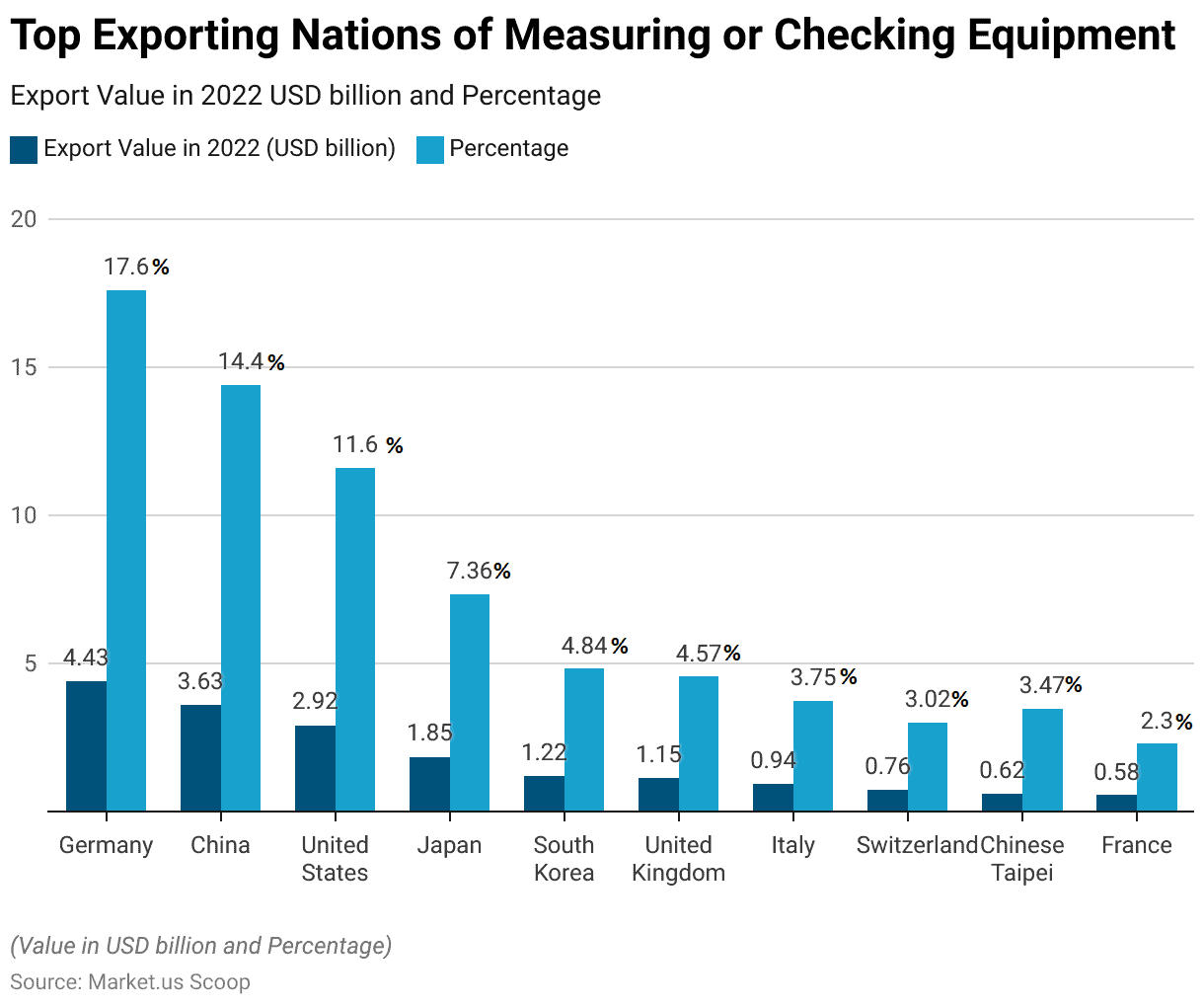
Test and Measurement Equipment Import Statistics
Top Nations Importing Measuring or Checking Equipment
- In 2022, China led the global market for importing measuring or checking equipment, with imports valued at USD 324 billion, accounting for 21.1% of the total market.
- The United States followed, importing equipment worth USD 139 billion, which constituted 9.07% of the global share.
- Germany was the third-largest importer, with USD 75 billion in imports, representing 4.89% of the market.
- France imported equipment valued at USD 68 billion, capturing 4.43% of the market, while India imported USD 64.7 billion, accounting for 4.22%.
- The United Kingdom and Mexico also had substantial import values of USD 61 billion (3.97%) and USD 54.2 billion (3.53%), respectively.
- South Korea’s imports stood at USD 50.3 billion, contributing 3.28% to the market, followed by Brazil with USD 41.2 billion (2.69%) and Japan with USD 32.6 billion, representing 2.13% of the global imports.
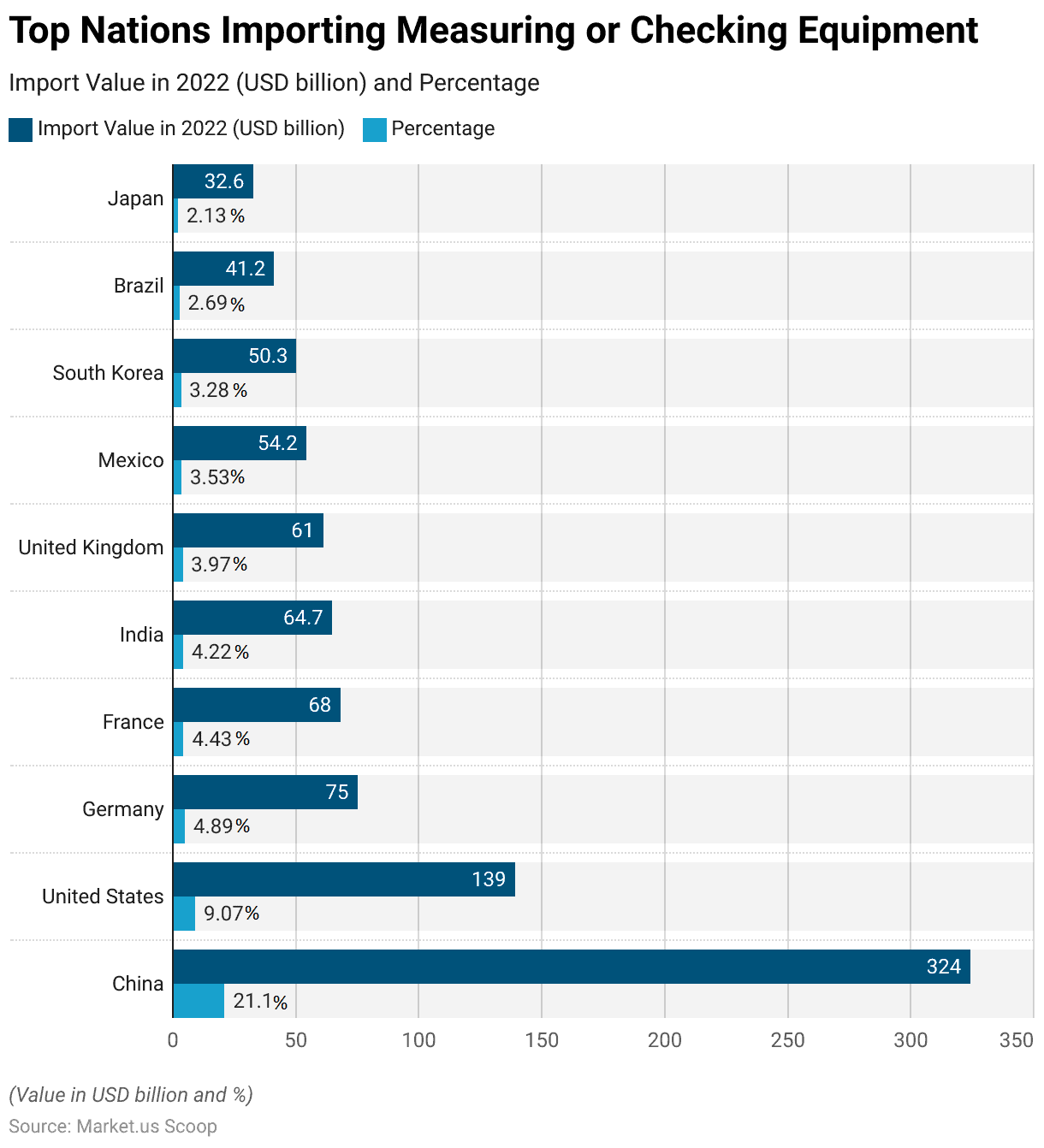
Regulations for Test and Measurement Equipment
- The regulations governing test and measurement equipment vary by country and are essential for ensuring the accuracy, reliability, and safety of these devices across different industries.
- In the United States, regulations such as those outlined by the National Institute of Standards and Technology (NIST) and compliance with standards like ISO/IEC 17025 ensure high precision and calibration in measurement tools.
- The European Union adheres to regulations under the IEC/EN standards, including IEC 61010-1, which mandates rigorous risk assessments and safety evaluations for electronic testing equipment.
- Similarly, in China, adherence to national standards (GB standards) and periodic updates to align with international norms are critical for maintaining market integrity.
- Saudi Arabia, with its significant investments in industrial development and the Machine Vision 2030 initiative, also imposes strict regulatory standards to ensure quality and compliance in its test and measurement sector.
Discuss your needs with our analyst
Please share your requirements with more details so our analyst can check if they can solve your problem(s)



